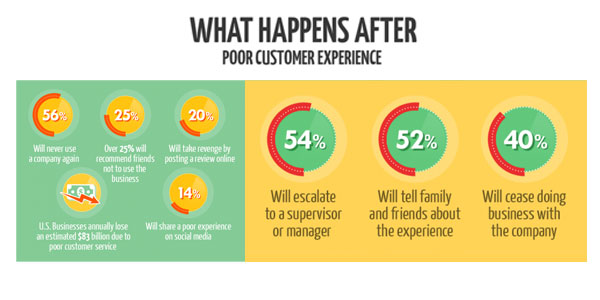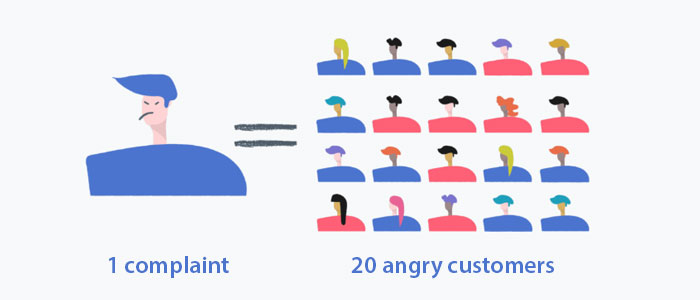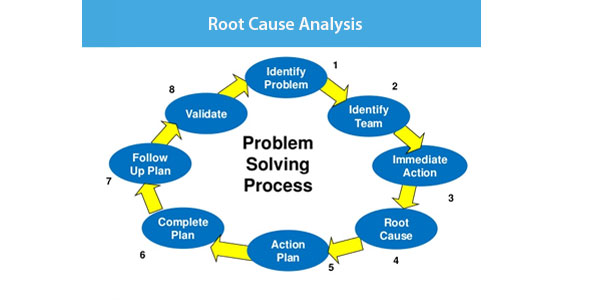Managing customers is an art that every business needs to master. But how to deal with angry and difficult customers vary from business to business and is an integral part of building customer relationships.
When customers are served properly they are satisfied with the experience and business grows. However, if customers are upset with your service, a bad experience can impact your business and bottom line.
Companies that invest in new technologies to provide best customer service, experience a significant 81% improvement in customer satisfaction.
This is how businesses are likely to deal with difficult customer situations. So, let us discuss their common types and how to deal with angry customers.
Common types of difficult customers
Identifying which customer type you are dealing with is the first step to successfully handling the situation when we talk about how to deal with angry customers. When you know what is the category of difficult customers you are dealing with, you can be prepared in handling the difficult customer scenario effectively.
Here are common types of customers who are difficult to handle and any business might encounter.
Indecisive Customer
Customers who are not firm enough to make a decision no matter how many questions they ask. As a business, what you can do is acknowledge the indecision and avoid being pushy. Instead, help them to make a decision by offering facts and possible best solutions for their needs.
Highly Critical Customer
Critical customers can be a big challenge for businesses. They seem to know it all and are very critical of your suggestions. It is advised to be patient and attentive and does not take anything personally. You can use clarifying statements, weaving in new information and ideas about the product of which they are being critical.
Aggressive Customer
The aggressive customers are angry and feel their needs should be prioritized above all. You need to stay calm and never argue with them. Try and avoid responding to their arguments in an agitated or emotional manner. Instead, show you understand and look for alternatives and offer other solutions.
When customers have a single or multiple bad experiences they become aggressive and let’s see what happens after poor customer experience.
Tips to deal with difficult or angry customers
You have to approach each encounter uniquely and cater your communication method to the customer type you’re working with. Just think about shifting your mindset and look at every interaction as an opportunity to build rapport. If you play your cards right, you are likely to end up with a returning customer and in turn, avoiding customer churn.
With the right tips and tactics, discussed below you will be prepared to navigate any situation that comes your way.
Here are 10 tips on how to turn a bad customer service situation into an opportunity to improve your business.
1. Follow active listening
The first and foremost thing is to listen patiently to your customers, especially when they are angry. Allow them to speak and you should lend your ears with full attention to understand what exactly went wrong that the customer is so angry.
Active listening helps to understand their problem thoroughly and look for the best alternatives to provide feasible solutions. With active listening skills, you can handle the situation better and also calm down the customer.
Here are some tips to be followed:
- Do not try to talk over the customer or argue with angry and difficult customers.
- Let the customer have their say, even if you know what they are going to say next, and even if they may not have all the information or be mistaken.
- As you listen, take the opportunity to build rapport with the customer.
2. Offer real time support
Real time is everything in customer service, but just how timely does your brand need to be?
Forrester Research found that 77% of U.S. adults online claim that valuing their time is the most important thing a brand could do to provide strong service.
The slightest delay in responding to customers is one of the main reasons why customers leave you getting frustrated. A single angry customer equals ten angry customers as they will share their experience with a bad word of mouth.
How to deal with such difficult customer scenarios?
- You can use live chat to provide real time assistance to sales & support queries and avoid getting customers from annoyed.
- Implement advanced tools like co-browsing and video to collaborate with customers and deliver effective solutions in the first contact.
- You can use AI chatbots to automate some parts of your customer support.
3. Be empathetic to build a good rapport
The old proverb is so appropriate here – “Put yourself in your customer’s shoes”.
When you do so you can closely associate yourself with the problem and the situation your customer is going through. You are able to understand the source of their frustration. At times, you can relate to some of the instances you have encountered and be empathetic with the customers.
When you are able to identify the root cause of their anger, you can outline ways to calm them down. If you verbally nod your head during the call to acknowledge his statements, the customer will not feel better understood.
Here are some tactics on how to deal with difficult customers:
- Use positive words and phrases like while handling angry customers.
- The tone is a very important part of healthy communication. The common mistake of using passive-aggressive language (“Actually…”) or confusing customers with slang or technical jargon that needs to be avoided.
4. Never take things personally
Always speak to the problem at hand and do not get personal. Keep in mind that customers do not know you in person and they are just venting their frustration at you as a support representative.
At times, the level of frustration is so high that customers become verbally abusive – take a deep breath and continue as if you didn’t hear them. It is advisable not to respond in such situations to avoid it from escalating in a negative direction.
Some pro tips to follow on how to respond to angry customers are:
- Gently guide the conversation back to the issue and how you intend to resolve it. Try to ignore personal comments made by the customer.
- You can politely remind the customers that you are there to help them and their best immediate chance of resolving the situation. Using simple statements helps to defuse such a steaming situation.
5. Identify the root cause of the problem
The customer may be angry due to many reasons but it is crucial to identify the root cause for come up with quick and effective problem solving.
Root Cause Analysis (RCA) is a simple technique performed with the objective of understanding the cause of the problem. It is the means to get to the underlying cause of the problem that has infuriated the customers.
The steps RCA includes that helps you in how to handle angry customers are as listed below:
- Identify the main problem and align with a customer need. Anticipate the problem from the customer’s perspective.
- Collect details relating to the problem and what is the measurable impact of the problem on key customer outcomes.
- Look for the root cause of the problem. What are the factors or combinations thereof leading to the issue?
- Identify solutions to the underlying problem and implement the changes.
- Defining a solution is not enough, execution is the key. Ensure the impact of the improvements are monitored and sustained.
The above steps define a simplified approach to how root cause problem solving blends into the operational excellence culture. The application may differ depending on the criticality of the issues.
6. Acknowledge & take actions quickly
Acknowledging customers is a crucial aspect of good customer service. When customers reach out to you with their problems, they expect a quick response. When customers get such responses, they feel happy and satisfied. They feel they are heard and valued.
According to Forbes, “when a customer is creating a scene in front of other customers, you should aim to resolve it as fast and quietly as possible. The reason quick actions is vital because they will immediately share their experience with friends, family, and other potential customers.”
Hence, you are capable to fix your customer’s issue immediately, then, by all means, do so.
The benefits your business can witness are while dealing with difficult customers are:
- Being able to quickly address a customer’s concerns may just turn their negative experience into a positive one. If you can get on top of things and satisfy the shopper, they might end up as a loyal customer who buys from you regularly and tells their friends.
- Resolving a customer’s issue ASAP also prevents a situation from escalating. This is especially true if someone is complaining loudly inside your store.
- Set autoresponder to send an instant receipt notification to customers whenever they report any issue.
- Define a specific service level agreement (SLA) as it serves as an acknowledgment to the customer query.
7. Apologize when needed
There is immense power in apologizing. And when an apology is made correctly, difficult customers can also be converted into happy customers. Engaging difficult customers is worth your time as they can be raving fans of your brand.
When you apologize to your customers, make them feel that you are genuinely sorry for the problem they are facing, no matter you think they really deserve an apology or not. It will help them to calm down to normal.
The below tips can help to calm down the angry customers.
- Being empathetic while apologizing can go a long way. Sometimes upset customers just want to have someone apologize to them for the bad service.
- You can cool down your furious customers by compensating them along with an apology. It can pacify their angry mood to a great extent.
8. Seek customer feedback
Brands should never underestimate the true value of customer feedback and complaints. Instead of ignoring them, you need to listen to irate customers, engage with them and keep them close. Customers, both happy and angry ones, are a valuable source of insight. Brands that ignore their dealing with angry customers risk losing out on valuable information that could propel their business forward.
Angry and difficult customers can identify opportunities for business improvements. The cost of angry and difficult customers can be high – likewise, converting them into advocates can have a huge impact on your business.
- The key is making sure you have a conduit for hearing these complaints and facilitating ongoing engagement, learning, and improvement. Doing so demonstrates a degree of authenticity and thoughtfulness that consumers yearn for in an age of mass commerce.
- Share the feedback with the potential team members across the different departments to know more about customer expectations.
- Identify the gaps between your brand and customers. Based on that, you can plan new business strategies to bridge the gaps.
9. Keep your commitments
When you make commitments to your customers make sure that you meet it. Even if you promised an update that you don’t have yet, convey the customer at the scheduled time anyway. This will not enrage your customers.
In fact, the customers will be reassured to know that you were not trying to dodge them and will appreciate the follow-up.
When your business has broken a promise, your employees should go above and beyond to solve their problems. They should reassure the customers that they will do whatever it takes to find a satisfactory solution.
Here are some tips on how to deal with angry customers:
- Never delay in acknowledging your angry and difficult customers. Respond to them with positive temperament and language.
- Apologize for the inconvenience they have encountered and show your concern towards them by providing the right solutions.
10. Follow up with customers
Follow up with your customers is crucial to know if the customers are happy with the product and services. When you reach out to your customers after a couple of days after the problem is fixed, it can work to your advantage such as:
- The most difficult customers will also appreciate this gesture, and it can go a long way toward rebuilding trust between with upset customers.
Conclusion
Dealing with angry customers is one of the most challenging parts of any business, but when handled correctly, you really can turn them into some of your strongest advocates. By infusing the above tips and best practices into your customer service strategies will help you with how to deal with irate customers.
How to deal with angry customers can be summarized into two main points.
- Manging angry customers differ from case to case. Identifying the root cause of frustration is essential, thereafter take quick actions in delivering solutions.
- Losing customers is 5x times costly than acquiring new customers. So on how to deal with difficult customers defines your customer service strategy.








also company can put a notice to avoid abusive customers “While we listen to our customer, but we also honor dignity of our colleagues. Please dont be abusive to them. If you have any complain, you can contact to . You will find this practice in many places in Singapore
yes that is a good practice to follow. Not to forget, managing online reputation for any company is every employee’s responsibility. Having a customer focused approach would help angry customers to communicate easily without leaving a feeling that they are not being heard!
The best way to assist angry customer and defuse the situation is in live conversation over the phone and as soon as possible. E-mail is not the best option here even for follow up. Letting customer fully vent without rushing him (her) or interrupting is also very important even though you maybe very eager to help and be in the position to do so immediately. Good article with the very common sense point.
Thanks Sasha for your appreciation. You are absolutely correct. Talking over the phone or live chat should be the best possible ways to handle the situation.
Its a really helpful article for us, who are providing live chat support. We hope there will be more helpful articles like this.
Thanks Nila for your appreciation. Please keep visiting for our upcoming blogs.
I think if any customer is angry he is not angry with the customers service executive they rather they are angry with the companies service. But an etiquette can make a difference though the customers is not happy with the service. At least they will get an impression companies employees are polite and knows the mannerism.
Yes Adam, you are absolutely right. So the customer care executive should not take it personally and should professionally handle the situation. As I have mentioned in my blog, if he/she is unable to manage the situation, then he can ask help from his seniors.
I really appreciate your suggestion. I also suggest my agents to follow the article as “Code of Angry customer dealing” Thank you Suvashree Bhattacharya .
Thanks Yang for your appreciation. Please keep visiting for our upcoming blogs.
Angry customers are a challenge for any company and a customer representative. Hope these effective strategies for dealing with these difficult situations will be helpful for the company .
I am the owner of a service provider company” Thai spa and beauty salon ” and it is natural to be faced with some angry customers . Sometimes my employee get tried to convince them and I lose some of my customer . Now I think this article will be helpful to motivate my customer and my employees will be able to handle them effectively . thank you Author.
Thanks Thanawan for your appreciation. The tips will surely help your employees to handle tough situations with your customers. Please keep visiting for our upcoming blogs.